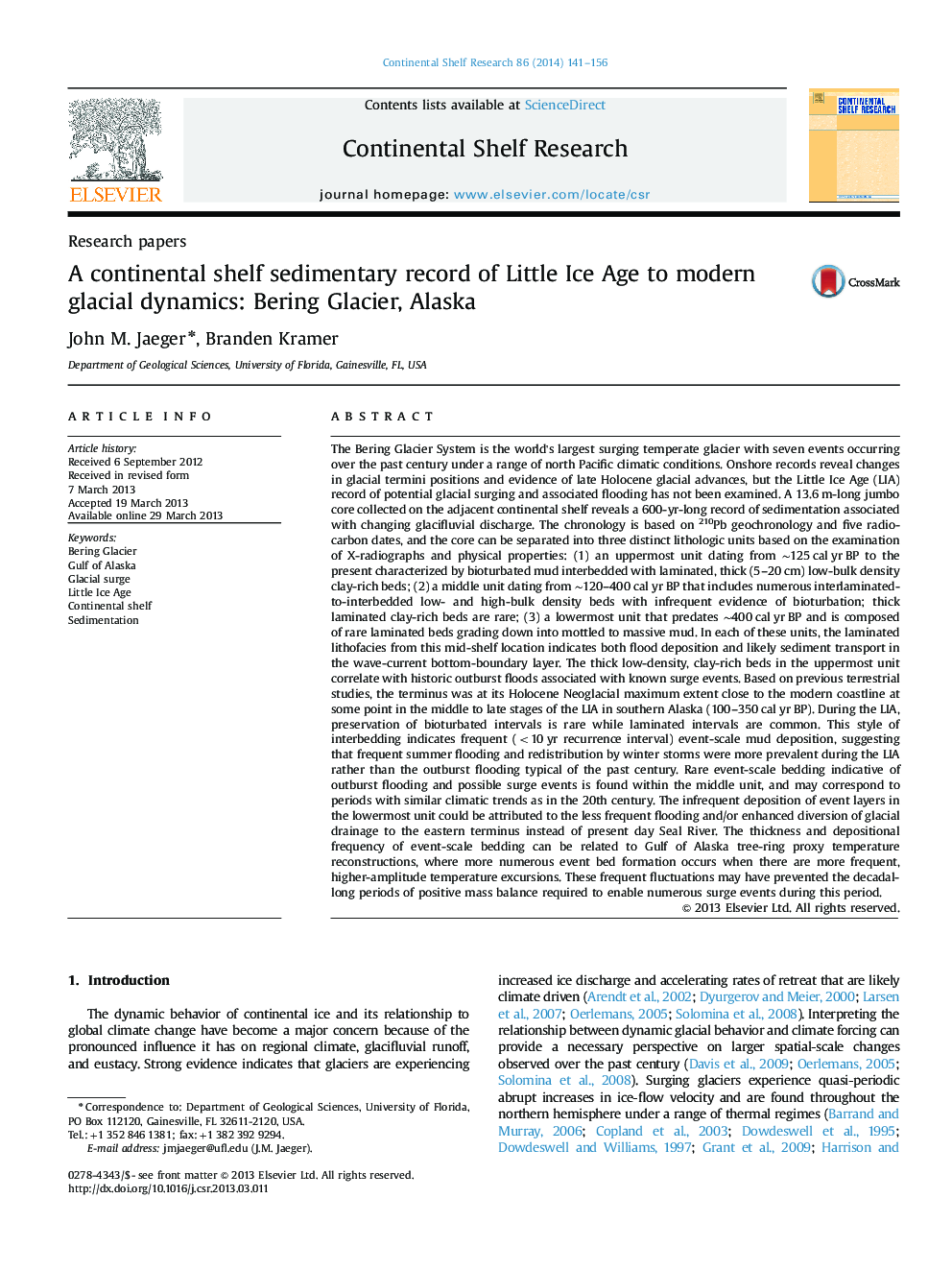| کد مقاله | کد نشریه | سال انتشار | مقاله انگلیسی | نسخه تمام متن |
|---|---|---|---|---|
| 4531853 | 1626126 | 2014 | 16 صفحه PDF | دانلود رایگان |

• A continental shelf sedimentary record near the Bering Glacier, Alaska is developed.
• A 600-yr-long record reveals deposition influenced by changing glacifluvial discharge.
• Three lithofacies units can be related to changes in the glacier's terminus position.
• Bering flooding frequency was greater during the Little Ice Age than the 20th century.
• Flood frequency can be related to regional temperature reconstructions.
The Bering Glacier System is the world's largest surging temperate glacier with seven events occurring over the past century under a range of north Pacific climatic conditions. Onshore records reveal changes in glacial termini positions and evidence of late Holocene glacial advances, but the Little Ice Age (LIA) record of potential glacial surging and associated flooding has not been examined. A 13.6 m-long jumbo core collected on the adjacent continental shelf reveals a 600-yr-long record of sedimentation associated with changing glacifluvial discharge. The chronology is based on 210Pb geochronology and five radiocarbon dates, and the core can be separated into three distinct lithologic units based on the examination of X-radiographs and physical properties: (1) an uppermost unit dating from ∼125 cal yr BP to the present characterized by bioturbated mud interbedded with laminated, thick (5–20 cm) low-bulk density clay-rich beds; (2) a middle unit dating from ∼120–400 cal yr BP that includes numerous interlaminated-to-interbedded low- and high-bulk density beds with infrequent evidence of bioturbation; thick laminated clay-rich beds are rare; (3) a lowermost unit that predates ∼400 cal yr BP and is composed of rare laminated beds grading down into mottled to massive mud. In each of these units, the laminated lithofacies from this mid-shelf location indicates both flood deposition and likely sediment transport in the wave-current bottom-boundary layer. The thick low-density, clay-rich beds in the uppermost unit correlate with historic outburst floods associated with known surge events. Based on previous terrestrial studies, the terminus was at its Holocene Neoglacial maximum extent close to the modern coastline at some point in the middle to late stages of the LIA in southern Alaska (100–350 cal yr BP). During the LIA, preservation of bioturbated intervals is rare while laminated intervals are common. This style of interbedding indicates frequent (<10 yr recurrence interval) event-scale mud deposition, suggesting that frequent summer flooding and redistribution by winter storms were more prevalent during the LIA rather than the outburst flooding typical of the past century. Rare event-scale bedding indicative of outburst flooding and possible surge events is found within the middle unit, and may correspond to periods with similar climatic trends as in the 20th century. The infrequent deposition of event layers in the lowermost unit could be attributed to the less frequent flooding and/or enhanced diversion of glacial drainage to the eastern terminus instead of present day Seal River. The thickness and depositional frequency of event-scale bedding can be related to Gulf of Alaska tree-ring proxy temperature reconstructions, where more numerous event bed formation occurs when there are more frequent, higher-amplitude temperature excursions. These frequent fluctuations may have prevented the decadal-long periods of positive mass balance required to enable numerous surge events during this period.
Journal: Continental Shelf Research - Volume 86, 1 September 2014, Pages 141–156